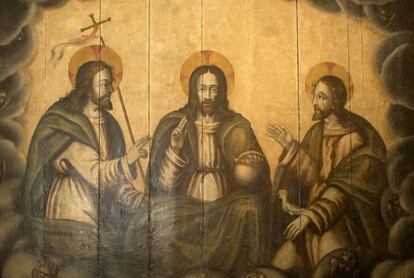Mallorca cathedral restores original chapel to mark 666th year
Never-finished temple has been renovated by Gaudí and Barceló

The cathedral of Palma de Mallorca, which remains under construction ("it's always collapsing," complained the statesman Jovellanos in the early 19th century), has just retouched its roots: the small chapel-and-vestry dating back to the early 1300s that was the germ for the larger building, which was itself built over the mosque of Madina Mayurqa.
Church officials called the chapel "a treasure" and "a crucial spot" where the first stones were laid for the great cathedral.
The reopening of the chapel served to mark the 666th anniversary of the "dedication" of this building in 1346. Dean Joan Bauzá joked that he hoped the triple digit would be "an omen of good luck, not of the wild beast of the Apocalypse," a reference to the fact the number 666 is associated with Satan.
For two days, visitors will be allowed to enter the small chapel, which has been returned to its original bare state and will be used for cultural events.
For the first time, the cathedral will also grant visitors access to its terraces.
In a few months, after the bells and the medieval structure that contains them are also restored, church officials hope to organize public tours of the upper portion of the cathedral, where the sky and the sea of Palma de Mallorca are framed by the pinnacles, the stained-glass windows and the giant rose window.
However, potential visitors should bear in mind that reaching the rooftop involves climbing 200 steps of one of the narrow spiral staircases inside each of the towers, where the walls still show medieval graffiti made by the refugees and fugitives who once hid out here.
The cathedral receives around a million visitors and worshippers a year, say church officials. Many people come to see the ceramic chapel recently created by artist Miquel Barceló, as well as the 1900 reforms made by Gaudí.
Tu suscripción se está usando en otro dispositivo
¿Quieres añadir otro usuario a tu suscripción?
Si continúas leyendo en este dispositivo, no se podrá leer en el otro.
FlechaTu suscripción se está usando en otro dispositivo y solo puedes acceder a EL PAÍS desde un dispositivo a la vez.
Si quieres compartir tu cuenta, cambia tu suscripción a la modalidad Premium, así podrás añadir otro usuario. Cada uno accederá con su propia cuenta de email, lo que os permitirá personalizar vuestra experiencia en EL PAÍS.
¿Tienes una suscripción de empresa? Accede aquí para contratar más cuentas.
En el caso de no saber quién está usando tu cuenta, te recomendamos cambiar tu contraseña aquí.
Si decides continuar compartiendo tu cuenta, este mensaje se mostrará en tu dispositivo y en el de la otra persona que está usando tu cuenta de forma indefinida, afectando a tu experiencia de lectura. Puedes consultar aquí los términos y condiciones de la suscripción digital.
Últimas noticias
Maduro pleads not guilty before the federal court in New York: ‘I am still the president of Venezuela’
A new test can detect Alzheimer’s from a finger prick
UN team enters Sudanese city of El Fasher after paramilitary massacre: ‘It’s like a ghost town’
A recipe for resistance: Indigenous peoples politicize their struggles from the kitchen
Most viewed
- Gilles Lipovetsky: ‘If you want to live better and fall in love, take Prozac, don’t look to philosophy’
- Alain Aspect, Nobel laureate in physics: ‘Einstein was so smart that he would have had to recognize quantum entanglement’
- Maduro’s downfall puts China’s relationship with Venezuela to the test
- Why oil has been at the center of Venezuela-US conflicts for decades
- Alvin Hellerstein, a 92-year-old judge appointed by Bill Clinton, to preside over Maduro’s trial in New York








































